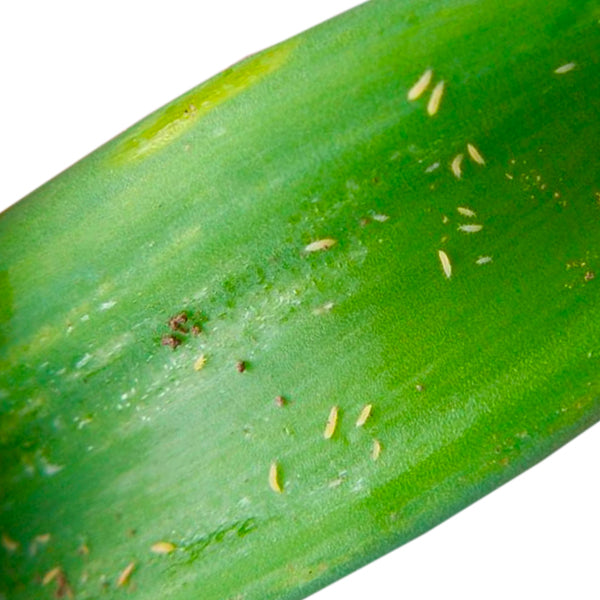Common Orchid Pests and How to Treat Them

Even well-cared-for orchids can occasionally face pest problems. Early detection and proper treatment are crucial for maintaining healthy plants. Here's your guide to identifying and treating common orchid pests.
Early Detection & Monitoring
Regular inspection is your first line of defense against pests. Examine your orchids weekly, paying special attention to:
- Leaf undersides and crevices where pests often hide
- New growth, which is particularly attractive to pests
- Signs of damage like stippling, yellowing, or deformed growth
- Sticky residue that might indicate pest presence
Local Resources
For pest control products and expert advice in the Fraser Valley area, visit:
- Amsterdam Greenhouses in Pitt Meadows
- DeVanco Garden Centre in Aldergrove
- Paramount Orchids in Abbotsford
Always consult with local experts for treatment recommendations suited to our climate.
Spider Mites
These tiny pests appear as small red or brown dots on leaves and create fine webbing.
Treatment:
Spider mites thrive in warm, dry conditions. Combat them with these methods:
- Increase humidity to discourage infestation
- Wipe leaves with insecticidal soap solution
- Use neem oil for persistent problems
- Consider predatory mites for biological control
- Maintain humidity above 50% to prevent reinfestation
Quality insecticidal soaps and neem oil products are available at GardenWorks Mandeville. For severe infestations, consider systemic treatments available at local garden centers.
Mealybugs
Appear as white, cottony masses in leaf axils and on roots.
Treatment:
Mealybugs can quickly spread between plants. Take these steps:
- Remove visible bugs with alcohol-dipped cotton swab
- Spray with insecticidal soap
- Isolate affected plants to prevent spread
- Treat the potting medium as eggs may be present
- Monitor nearby plants for at least three weeks
- Consider repotting if root infestation is severe
Scale Insects
Look for small, brown, oval bumps on leaves and stems.
Treatment:
Scale insects can be persistent. Follow this treatment plan:
- Scrape off visible scale with soft brush
- Apply horticultural oil
- Repeat treatment after 7-10 days
- Use systemic insecticide for severe cases
- Check for scale under sheaths and in leaf axils
- Clean all tools after treating infected plants
Aphids
Small, soft-bodied insects that cluster on new growth and flower spikes.
Treatment:
While aphids are easier to control than some pests, prompt action is important:
- Rinse off with strong water spray
- Apply insecticidal soap
- Use systemic insecticide for severe infestations
- Remove and dispose of heavily infested flower spikes
- Consider beneficial insects like ladybugs
- Monitor new growth carefully during spring
Thrips
Tiny, elongated insects that cause stippling and deformed flowers.
Treatment:
Thrips can be particularly damaging to flowers and new growth:
- Use blue sticky traps to monitor populations
- Apply insecticidal soap or neem oil
- Remove damaged flowers and buds
- Consider systemic insecticides for severe cases
- Maintain good air circulation
Prevention Tips
The best treatment is prevention:
- Regularly inspect plants
- Maintain good air circulation
- Quarantine new plants for 2-3 weeks
- Keep growing area clean
- Use sterile potting media
- Avoid overwatering and excess fertilizer
- Clean tools between plants
- Monitor temperature and humidity levels
Biological Control Options
Consider these natural pest control methods:
- Predatory mites for spider mite control
- Ladybugs for aphid management
- Beneficial nematodes for soil pests
- Parasitic wasps for various pests
Climate Considerations
The Fraser Valley's climate can affect pest populations:
- Higher humidity in winter may increase fungal issues
- Spider mites often surge during dry summer months
- Greenhouse pests may be active year-round
- Monitor more frequently during seasonal changes
Remember to always test treatments on a small area first and avoid treating plants in direct sunlight to prevent leaf burn. For hands-on guidance, join our monthly meetings at the Langley Community Centre where we regularly discuss pest management strategies for the Fraser Valley region.
When to Seek Expert Help
Consider consulting a professional if:
- Multiple treatment attempts have failed
- You can't identify the pest
- The infestation is severe or spreading rapidly
- You have rare or valuable specimens at risk
Local expertise is available through our society members and at our monthly meetings. Bring affected plants (in sealed bags) to meetings for diagnosis and treatment recommendations.
About the Author
Emily Roberts is an experienced orchid grower and active member of the Fraser Valley Orchid Society. They share their knowledge through our blog and monthly meetings.